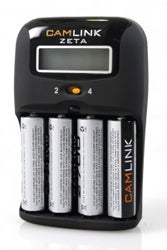Photography needn't be prohibitively expensive u2013 here are 12 ways to save money on your photography and camera equipment
Money Saving Photography Tips
Between new cameras, new lenses and the ever-expanding
universe of related accessories photography can quickly become a very expensive
hobby indeed. That said, there are a number of ways you can save yourself
considerable amount of money. Sometimes this might involve buying slightly
older equipment and sometimes it might be crafting your own equipment from
everyday items. Without further ado, here are twelve ways to save money on your photography and camera equipment…
1. Buy Last Year’s
Models

One of the best – if not always the easiest – ways to save
tens, if not hundreds, of pounds is to have a bit of patience. Digital cameras
are constantly evolving and, in the compact and compact system camera markets
especially, standard shelf lives are shrinking fast. Whereas it used to be the
case that new cameras could expect to last for around a year before a newer
version was released, these days it’s often closer to six months. This can be
good news for those with a bit of perseverance because while brand new cameras
always carry a price premium at launch, wait a month of two and the same camera
can usually be found at a discount. These discounts often get even bigger once
a newer model is close to release.
Of course, this doesn’t mean that you’ll be buying old, and
out-of-date technology – far from it. While manufacturers always like to
trumpet the advances they make in newer models, the digital camera market is already
pretty advanced and standards are generally high so buying a 2012 model isn’t
really going to cost you in terms of image quality, although it could well save
you quite a bit of money.
2. Buy Online

If you’re in the market for a new camera then it always pays
to walk into a shop and have a good look at the specific models on your shortlist.
If your shop is a reputable one, you’ll also be able to get some sound advice
from the staff who work there as well as decent customer service should
something go wrong with your new item after you’ve purchased it – this alone
can sometimes be worth spending a bit extra for.
That said, physical shops do, of course, have much bigger
overheads that internet retailers do, which usually means cameras and
accessories are cheaper to buy online than on the High Street. That’s not to
say that Amazon should be your only resource for buying new gear from. On the
contrary, why not try and negotiate a deal with your local shop and see if they
can match, or at least come close, to some of the online prices you’ve found. You’ll
often find that some chains with shops on the high street also offer internet
exclusive deals on some of their stock, so be sure to check if this is an
option too. If you can’t get a deal and you want pure value for money then try
taking a look at our Best Online deals page ,
which we produce with the assistance of Revoo and update every week.
While online shopping can usually secure you the best
prices, two things to steer clear of are buying from abroad and grey imports.
In both cases you may well find that your camera doesn’t come with English
instructions or a UK mains plug, in addition to which you could also find that
the servicing and returns policy is a really complicated, not to mention
costly, process as grey imports and cameras purchased overseas don’t benefit from
the same warranties of official UK stock bought though authorised retailers. Of
course it’s not so bad if you’re just after some filters or a bag, but grey
imports and foreign purchases of expensive DSLRs and other costly equipment are
best avoided altogether.
3. Buy at Trade
Shows/Open Days

While they don’t happen with all that much regularity, trade
shows and open days are still a great way to see lots of photography equipment
from numerous manufacturers in one place and, quite often, to walk away with
some excellent discounts.
While Europe’s largest photography trade show, Focus on
Imaging, has sadly ceased to be there are still a number worth looking out for.
The Photography Show has been announced as a replacement for Focus and is
scheduled to take place at the Birmingham NEC in March 2014. Much smaller but still
well attended is the Societies (SWPP) Photographic Convention, which takes
place in London in January. You won’t find any of the major manufacturers
directly represented at SWPP, but you will find plenty of retailers offering
good discounts on equipment and accessories. Photovision Roadshows, meanwhile,
is a touring exhibition that moves around the UK, although here the focus is
more on photographic services for professionals than anything else.
As far as open days go, many of the bigger retailers throw
open their doors once or twice a year to showcase demonstrations from major
manufacturers, usually accompanied by some good one-off discounts. WEX
Photographic, Calumet and Park Cameras are but three retailers who run days
like this so it’s always worth checking with your local store to see if they
have anything planned.
4. Buy Second-hand

Buying second-hand, ‘nearly new’ or ‘ex-demo’ equipment is
another good way to save money, although of course it does carry some additional
risks to buying new goods that you need to be wary of.
If buying second-hand, especially from a stranger, be sure
to verify the condition of the equipment before handing any money over and make
sure you also understand the seller’s returns policy in case the seller’s
description doesn’t match the actual condition of the equipment. With newer
items it’s also worth asking whether there’s any warranty left over in case you
do have a problem.
Don’t worry too much though; if you’ve done your research
and can find a trustworthy seller, then there are plenty of second-hand
bargains to be had and you could save yourself a huge amount of money.
Buying ex-demo equipment is another way to save money.
Admittedly, opportunities to purchase this way are rare and you should certainly
never rush into anything purely because of the discount on offer. However if
the item in question has been well looked after and is in good condition then
it may be worth a shot – just be sure to negotiate some kind of in-store
warranty or guarantee on the item before entering into any agreement.
5. Use Old Lenses
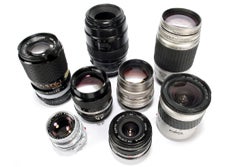
If you own a DSLR and are on the hunt for new glass, then
you may be able to save money by using an older lens. If you graduated to
digital from 35mm film DSLRs then you may already own a number of lenses already.
The main thing to look out for is lens mount compatibility.
For example, Canon DSLRs use the EF mount, which was introduced in 1987. Prior
to this Canon 35mm film SLRs used the FD mount, and while the FD lenses cannot
be attached directly to EF-mount DSLRs it is possible to buy an adaptor.
Another thing to be aware of is autofocus compatibility.
Whereas the vast majority of contemporary lenses offer autofocus capabilities -
either built-in or through the camera – some older lenses do not. A small
number of these can even damage modern DSLRs. For example, Nikon has used the
F-mount since 1959 and while most older Nikon F lenses are fine on modern Nikon
DSLRs, those manufactured before 1977 without a secondary
aperture ring or pre-AI (automatic indexing) can damage modern cameras and are
best avoided.
Pentax users,
meanwhile, can use just about all K-mount lenses manufactured from 1975
onwards, although there may be some limitations with certain features. Older
Pentax lenses also need to have the aperture ring set to A to allow full
control too.
Sony is a recently
recent manufacturer of DSLR’s following its acquisition of Konica-Minolta in
2006. Thanks to this business deal Sony DSLR owners are able to mount old
Minolta AF-mount lenses on their Sony Alpha DSLRs.
Last but not least, Olympus
DSLR owners can use older Zuiko lenses designed for Olympus OM 35mm film SLRs
on modern Olympus interchangeable lens cameras using the Micro Four Thirds
system.
6. Use Free Software
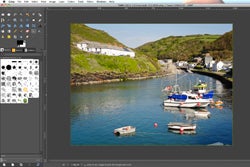
While Photoshop might be the industry standard for image
editing, it certainly doesn’t come cheap at around £650 for a boxed copy (while
stocks last) or around £40 a month as part of Adobe’s monthly Creative Cloud
membership scheme. Thankfully though there are plenty of cheaper – and even
free – alternatives if you know where to look. For those who absolutely must
have Adobe software, Photoshop Elements 11 is available for around £50. At
around £60 Corel’s PaintShop Pro X5 is another good alternative.
For those looking to save even more money, then the best
place to go is online where there’s a wealth of free image editing and photo
management software – often referred to as freeware – available. These applications
come in all shapes and sizes, with varying degrees of complexity – from basic
image editing tools such as Picasa and Fotoflexer, to more advanced
applications such as GIMP and Pixlr. In addition, hunt around and you’ll also
find free software that can be used for all manner of requirements – from
recovering ‘deleted’ image files on your computer or memory card to blending
multiple images into a single ‘HDR’ image. For a full round-up of all the best
free applications check out our Guide to Free Photo Editing Software.
As with all applications downloaded from the internet, be
sure to only download your software direct from the application makers or other
trustworthy software sites, otherwise you could well find that you get more
than your bargained for.
7. Take Advantage of
Free Printing Offers
Sending your images off to professional printers can quickly
get expensive, however if you look online you’ll find there are plenty of deals
to be had including free printing offers. These are usually offered as a
first-time signing up bonus so obviously you can’t use them all the time.
However if you’ve got a selection of your favourite images ready to go and your
want to get some prints made then taking advantage of the free sign-up offers
is definitely a good place to start. The costs involved – along with the quality
of prints – does vary from company to company mind, so be sure to check our
Guide to Online Printing Services first.
8. Make Your Own
Reflector

This is one of the
easiest accessories to make on the cheap, and can easily be fashioned from
things you probably already have lying around your home. To create a silver
reflector, find yourself a large piece of card (the side of a cardboard box is
ideal). You can go as large as you like but half a metre to a metre is plenty.
Then take some regular kitchen foil and cover the surface of the card, shiny
side out. Secure it with sticky tape or glue around the edge, and you have
yourself a functional silver reflector – the type that’s often used in
commercial fashion photography. For more subtle results try using white paper or
white plastic instead. The results should be fairly good but if you’re using it
in public you probably won’t pass for a pro!
9. Make Your Own
Diffuser
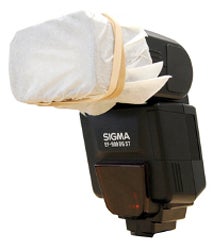
Direct light can
produce harsh shadows but by adding a diffuser you can create a softer even
light source. Though dedicated diffusers aren’t that pricey, free is always
better. If you are using a flashgun use a rubber band to secure some white
paper over the front of the flash. For smaller flashes a single piece of
masking tape across the front can work too. For a still-life set-up try taping
or holding a piece of masking tape in front of a desk lamp for a softbox
effect. Though, beware that it doesn’t get too hot.
10. Use Rechargeable Batteries
Why do some people still buy disposable AA batteries when rechargeables work out so much cheaper and are so much better for the environment? Even if your camera doesn’t use AA’s (a few still do) your flashgun almost certainly will, and various other devices use them too. Switching to rechargeables will save you a fortune in the long run, and the latest generation are better than ever.
11. Enter Photo
Competitions

Why not try entering
your work into a competition – a quick Google search returns hundreds of
possibilities, including many run by photography websites and magazines including WDC.com
Obviously the standard will vary between competitions so do your research and
submit your entries realistically and accordingly. Obviously, it’s all but
impossible to cater for the particular tastes of judges, but if you choose the
right image and enter it into the right competition then you might just win a
great prize and (just as importantly) recognition of your photographic skills. Many
competitions can be entered online, and are generally free to participate in.
Obviously you’ll have to pay some postage costs if you need to submit a physical
print somewhere, but this isn’t usually much. Best of luck!
12. Save Costs on
Models
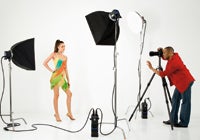
If you’re looking to take
professional-looking portrait shots, it makes sense to use a proper model
rather than just friends and family. Models are used to pulling the right poses
and therefore you can concentrate on taking the pictures rather than managing
people who don’t really want their picture taken. The problem with this is that
professional models can be very expensive. There are, however, several websites
designed to unite aspiring models with photographers, thereby allowing both to
bolster their portfolios. Established sites include Model Mayhem and The Model
Book. Most shoots take place on a Time For Prints (TFP) basis, or with a small
payment for the models. Some sites will allow you to cast for shoots while
others will require you to search for models living nearby. Before shooting
anything though, be sure you get the model to sign a model release form and
make sure you supply them with your end of the bargain – the prints – in an
agreed format.






